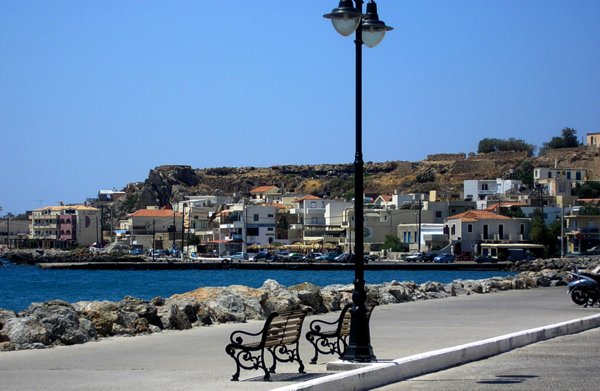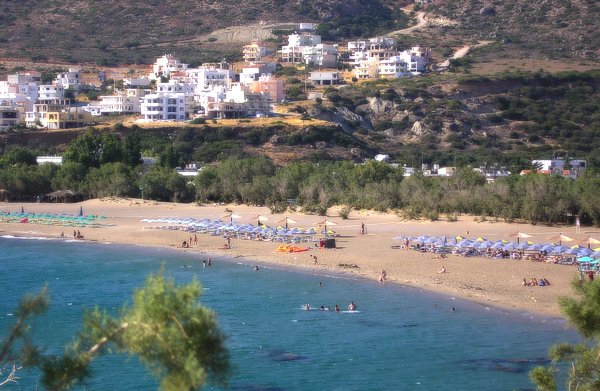Paleόchora (GR: Παλαιόχωρα & Παλιόχωρα) - the pearl of the Libyan Sea! - is built on a small peninsular, on the south - west shores of the island. Surrounded by mountains and beaches Paleohora is one one of the top destinations for the visitors to Crete. Along the western side is a long sandy beach fringed by trees and tavernas and on the eastern side lies the old town, the ferry dock and a long pebble beach lined with picturesque tavernas. At the tip of the peninsular is the remains of an old Venetian (Selino Kasteli) fort and a marina.
The population of the broader area of Paleohora reaches 2000 permanent residents. The local economy is based mainly on tourism and agriculture.

Access
The best way to reach Paleochora is by car via the north axis national road from the junction at Tavronitis.
The distance from the town of Hania is around 72 kms and from Hania Airport around 90kms.
Regular public bus service is available from/ to Chania town:
Hania - Palaeochora
Daily: 05:00, 08:30, 12:45, 16:00
Paleochora - Hania
MONDAY TO FRIDAY
07:30 11:00 15:30 18:15
SATURDAY
07:30 15:30 18:15
SUNDAY
11:00 18:15
Price = 8,80* € | Travel time about 90 minutes
For updated information on bus schedules
click here
Taxi from Hania takes about 75 minutes and costs 100* Euro each way. From Heraklion the journey is around 3 hours and one way costs 230* Euro.
* Indicative prices.
Facilities
Accommodation is offered in hotels, apartments, studios, rooms of all types and categories. Paleohora receives thousands of visitors each year and the vast majority of them is treated as special guests by the locals who are renowned for their hospitality and friendly character.
Excellent and reasonably priced local and international specialties are offered in the cozy restaurants and picturesque taverns of Paleohora. The streets around the center close for the motor vehicles in the afternoon so the atmosphere is getting lively and friendly.
Although nightlife is not what most visitors are looking for in Paleohora, there are good options available with small bars and discos staying open until late in the night.
Shops cover, at least, all the basic needs both for locals and visitors.
There are also banks, ATMs, post office, medical center, private doctors, drugstore, police station, port authorities, custom house, a marina and generally all the amenities that a modern and busy town should offer.

The beaches
The town is built between two small bays and has on both sides well organised beaches with clear waters awarded with the blue flag. On the eastern side a long pebble beach named "Halikia" with view to the white mountains and on the western side "Pahia Ammos", a wonderful beach with gold fine sand and lined with tamarisks.
Apart from those two beaches there is a number of pebble or sandy beaches both to the west (Psilos Volakas, Karavopetra, Plakaki, Grammeno, Agia Kyriaki, Krios) and the east (Gialiskari and Anydri) of the town accessed by car in just a few minutes drive.
Sight seeing
The castle at Fortezza, a ruined fortress built by the Venetians in 1282 on the low hill overlooking the town and the two bays.
The Acrites Museum which was founded within Acrinet European framework by the folklore centre of Athens Academy. Palaiohora was chosen for the foundation of the museum because the area still preserves the legends of the acrites and Digenis Acritas achievements through songs, place - names ant wall paintings.
There are plenty of
Byzantine and post-Byzantine churches with wonderful frescoes, in the town and the surrounding area.
Excursions
Small boats offer short cruises to the open sea, where the Mediterranean whales and dolphins can be observed.
There are also scheduled daily trips to places around Paleohora such as Elafonissi, Sougia, Agia Roumeli, Loutro , Sfakia and the island of Gavdos.
Tickets can be obtained locally.
Hiking and walking can also be interesting options as there are many caves, secluded beaches and small ravines in the area.
History
It is believed that the ancient city of Kalamidi was situated in a short distance north of Paleohora. Very little is known about Kalamidi. It was probably the seaport of ancient Kandanos and flourished during the Doric and Roman times, along with the neighbouring cities of Syia (Sougia), Lissos, Pikilassos and Tara.
During Venetian occupation, Paleohora was called Selino Kasteli due to the fortress that was built on the "Fortezza Hill' by the Duke of Crete Marino Gradonico in 1282. Selino region, which was previously called Orina, took its name from that fortress, too.
In 1539, Pirate Barbarossa destroyed the fortress which was rebuilt again in 1595.